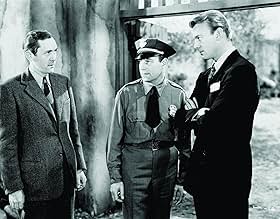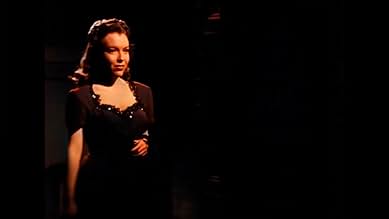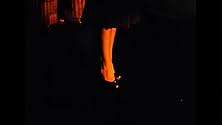Un léopard, utilisé lors d'une représentation de castagnettes, s'échappe apeuré par le bruit. Peu après, une série de meurtres touche la ville, mais, son propriétaire et le publicitaire qui ... Tout lireUn léopard, utilisé lors d'une représentation de castagnettes, s'échappe apeuré par le bruit. Peu après, une série de meurtres touche la ville, mais, son propriétaire et le publicitaire qui en avait la charge ne le croient pas responsable.Un léopard, utilisé lors d'une représentation de castagnettes, s'échappe apeuré par le bruit. Peu après, une série de meurtres touche la ville, mais, son propriétaire et le publicitaire qui en avait la charge ne le croient pas responsable.
- Réalisation
- Scénario
- Casting principal
- Récompenses
- 2 nominations au total
- Consuelo Contreras
- (as Tula Parma)
- Mexican Police Officer
- (non crédité)
- Dwight Brunton
- (non crédité)
- Nightclub Patron
- (non crédité)
- Nightclub Waiter
- (non crédité)
- Boy Singer
- (non crédité)
- Waiter Serving Helene and Dwight
- (non crédité)
- Young Lover
- (non crédité)
- Helene
- (non crédité)
- Coroner
- (non crédité)
Avis à la une
Based on the book "Black Alibi" written by Cornell Woolrich, The Leopard Man's only crime is that it's not as great as its two predecessors, Cat People & I Walked With A Zombie. Rest assured, though, this is still a quality Lewton/Tourneur production. As a story it's simple and straight, with a running time of just over one hour keeping it lean and devoid of pointless waffle, but the piece positively thrives on its atmosphere - dealing as it does in murky shadows and unease inducing periods of silence. It also boasts a number of sequences that linger long in the memory, be it blood seeping under a door, the bend of a tree branch, or the dark under belly of a railway bridge, for such a short sharp shock of a movie there's so much to enjoy. The work of cinematographer Robert De Grasse (Vivacious Lady/The Body Snatcher) is top class and worthy of indulgence from the film noir loving crowd.
What you don't see is more effective on account of the eerie sense of dread that Messrs Lewton/Tourneur/De Grasse have built up. A fine film and proof positive that classic spookers could be made from relatively small budgets. 7/10
Publicity agent Jerry Manning, Dennis O'Keefe, trying to spice up his client Kiki Walker, Jean Brooks, nightclub act gets her a black leopard from a local carnival to upstage her rival at the club Spanish dancer Clo Clo, Margo. On the first night of Kiki's act with the big cat the leopard gets startled by an angry Clo Clo who put her hand-clickers almost in it's face. The noise made the cat break away from Kiki as it disappears into the night.
With the local police as well as the towns people looking for the escaped black leopard it later crosses the path of young Teresa Guadalupe who's outside going to the store to get corn meal for her mother to make dinner. Terrified with fear at the sight of the almost demonic-looking black cat Teresa drops the bag of corn meal that she has and runs for her life with the leopard hot on her tail.
Getting to her house her mother doesn't let poor Teresa in because she didn't have the corn meal and thought that her story about her being chased by a big cat was just an excuse for her to let her in the house. A moment later there's a terrifying scream and then all is eerily quiet. Realizing that something is terribly wrong Teresa's mother runs to open the door she sees a stream of blood oozing under it, the cat killed little Teresa.
Terrifying movie that plays with ones nerves like a violinist pays with the strings of his violin. With sounds and shadows instead of special effects and really packs a wallop by doing it. There's three scenes in the movie where someone is killed including the one with Teresa and everyone of them brings the tension to such a hight where your nerves are at the point of breaking down. You just can't wait for the nerve racking scene to finally end where at the same time the director of the movie, Jacques Tourneur, keeps you totally in the dark to what's happening off screen.
Tourneur direction shows how the mind can be easily tricked and manipulated by an imaginative film maker with nothing more then lights sound & shadows. And thus brings far more shocks and jolts to his audience back in 1943 then what the best state-of-the-art special effects can do in a movie today.
Even though "Leopard Man" touched upon a lot of psychological aspects of the human, as well as animal, mind it pre-dates the movie "Spellbound" which many consider the first major Hollywood film about the subject by two years.
The films dark and eerie ending in the darkening New Mexican desert amid a black hooded precession to commemorate the 17th century slaughter of the towns original inhabitants, by the Spanish Conquistadors, was one of the most creepiest sights I've ever seen in a movie.
The star players are somewhat dull, but the supporting cast is quite good. And the merging and sometime colliding of the Anglo, Hispanic and Indian cultures is nicely presented. There is a sense of primitive feeling, of old religion, throughout the film, implied rather than stated, that is beyond the grasp of the hyper-rational lead players. We can catch this mood in fits and starts, but like the major characters, it eludes our grasp. Jacques Tourneur's direction is masterful every step of the way; and he uses music sensually yet emphatically, and the result is a fine-tuned film. It's major flaw is the revelation of the culprit, yet once Tourneur accepted the script's limitations he works superbly within them. The best thing about the movie is that its most crucial events happen mostly off-screen, leaving a good deal to our imaginations. And the minimalist script leaves a great deal in the dark, and even after the picture's florid, almost surreal climax, the air of mystery lingers. There are loose ends for sure, but Tourneur's polite, civilized touch dresses them up to appear profound and suggestive rather than threadbare, and the result is a pleasing conclusion that does not quite give the whole thing away; and we are left wanting to know just a little bit more. Tourneur was a true master.
Le saviez-vous
- AnecdotesIn the Summer of 1952, RKO reissued this film as a double feature with King Kong (1933). RKO cashed in, as young theatergoers, due to this film's title, were expecting to see a second creature film.
- GaffesAt the nightclub, Kiki is seated at a table with Jerry and Galbraith. As she asks Galbraith why he gave up teaching, a slim dark-haired woman wearing a matching suit and hat walks past their table. The shot cuts to Galbraith saying 'Various reasons', and the woman can be seen behind him (just over his shoulder on the far left of the screen), already seated at a nearby table.
- Citations
Charlie How-Come: You don't get the idea, mister. These cops banging those pans, flashing those lights, they're gonna scare that poor cat of mine. Cats are funny, mister. They don't want to hurt you, but if you scare them they go crazy. These cops, they don't know what they're doing.
- Versions alternativesSome older TV prints of "The Leopard Man" run 59 minutes.
- ConnexionsFeatured in Terror on Twelve: The Leopard Man (1964)
- Bandes originalesLas Mañanitas
(uncredited)
Traditional Mexican birthday song
Performed by Fely Franquelli and Ottola Nesmith
Meilleurs choix
Détails
- Durée
- 1h 6min(66 min)
- Couleur
- Rapport de forme
- 1.37 : 1
































